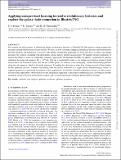Files in this item
Applying unsupervised learning to resolve evolutionary histories and explore the galaxy-halo connection in IllustrisTNG
Item metadata
| dc.contributor.author | Fraser, T S | |
| dc.contributor.author | Tojeiro, R | |
| dc.contributor.author | Chittenden, H G | |
| dc.date.accessioned | 2023-01-31T12:30:13Z | |
| dc.date.available | 2023-01-31T12:30:13Z | |
| dc.date.issued | 2023-07 | |
| dc.identifier | 283128461 | |
| dc.identifier | 880fcef9-a7e0-41b3-b97c-91890601af9c | |
| dc.identifier | 85161574823 | |
| dc.identifier.citation | Fraser , T S , Tojeiro , R & Chittenden , H G 2023 , ' Applying unsupervised learning to resolve evolutionary histories and explore the galaxy-halo connection in IllustrisTNG ' , Monthly Notices of the Royal Astronomical Society , vol. 522 , no. 4 , stad015 . https://doi.org/10.1093/mnras/stad015 | en |
| dc.identifier.issn | 0035-8711 | |
| dc.identifier.other | Jisc: 854181 | |
| dc.identifier.uri | https://hdl.handle.net/10023/26862 | |
| dc.description.abstract | We examine the effectiveness of identifying distinct evolutionary histories in IllustrisTNG-100 galaxies using unsupervised machine learning with Gaussian Mixture Models. We focus on how clustering compressed metallicity histories and star formation histories produces subpopulations of galaxies with distinct evolutionary properties (for both halo mass assembly and merger histories). By contrast, clustering with photometric colours fail to resolve such histories. We identify several populations of interest that reflect a variety of evolutionary scenarios supported by the literature. Notably, we identify a population of galaxies inhabiting the upper-red sequence, M* > 1010M⊙ that has a significantly higher ex-situ merger mass fraction present at fixed masses, and a star formation history that has yet to fully quench, in contrast to an overlapping, satellite-dominated population along the red sequence, which is distinctly quiescent. Extending the clustering to study four clusters instead of three further divides quiescent galaxies, while star forming ones are mostly contained in a single cluster, demonstrating a variety of supported pathways to quenching. In addition to these populations, we identify a handful of populations from our other clusters that are readily applicable to observational surveys, including a population related to post starburst (PSB) galaxies, allowing for possible extensions of this work in an observational context, and to corroborate results within the IllustrisTNG ecosystem. | |
| dc.format.extent | 19 | |
| dc.format.extent | 3298055 | |
| dc.language.iso | eng | |
| dc.relation.ispartof | Monthly Notices of the Royal Astronomical Society | en |
| dc.subject | Galaxies: evolution | en |
| dc.subject | Galaxies: formation | en |
| dc.subject | Methods: data analysis | en |
| dc.subject | QB Astronomy | en |
| dc.subject | QC Physics | en |
| dc.subject | DAS | en |
| dc.subject.lcc | QB | en |
| dc.subject.lcc | QC | en |
| dc.title | Applying unsupervised learning to resolve evolutionary histories and explore the galaxy-halo connection in IllustrisTNG | en |
| dc.type | Journal article | en |
| dc.contributor.institution | University of St Andrews. School of Physics and Astronomy | en |
| dc.identifier.doi | https://doi.org/10.1093/mnras/stad015 | |
| dc.description.status | Peer reviewed | en |
| dc.date.embargoedUntil | 2023-05-19 |
This item appears in the following Collection(s)
Items in the St Andrews Research Repository are protected by copyright, with all rights reserved, unless otherwise indicated.

